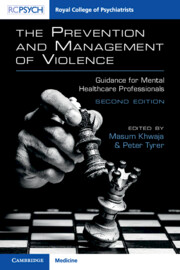Book contents
- The Prevention and Management of Violence
- The Prevention and Management of Violence
- Copyright page
- Dedication
- Contents
- Contributors
- Preface
- Abbreviations
- Section 1 General Aspects of Management
- Introduction to Section 1
- Chapter 1 The Need for a Common Set of Guidelines
- Chapter 2 Legislation Relevant to the Management of Violence by Persons With Mental Disorders
- Chapter 3 Protection and Safeguarding of Vulnerable Adults and Children Exposed to Violence
- Chapter 4 Anticipation and Reduction of Violence: Implications of the NICE 2015 Guideline
- Chapter 5 Post-Incident Management
- Section 2 Medical and Psychological Intervention
- Section 3 Violence in Different Settings
- Section 4 Management in Other Groups
- Section 5 Violence and Society
- Section 6 Engagement and Understanding
- Index
- References
Chapter 3 - Protection and Safeguarding of Vulnerable Adults and Children Exposed to Violence
from Section 1 - General Aspects of Management
Published online by Cambridge University Press: 09 May 2023
- The Prevention and Management of Violence
- The Prevention and Management of Violence
- Copyright page
- Dedication
- Contents
- Contributors
- Preface
- Abbreviations
- Section 1 General Aspects of Management
- Introduction to Section 1
- Chapter 1 The Need for a Common Set of Guidelines
- Chapter 2 Legislation Relevant to the Management of Violence by Persons With Mental Disorders
- Chapter 3 Protection and Safeguarding of Vulnerable Adults and Children Exposed to Violence
- Chapter 4 Anticipation and Reduction of Violence: Implications of the NICE 2015 Guideline
- Chapter 5 Post-Incident Management
- Section 2 Medical and Psychological Intervention
- Section 3 Violence in Different Settings
- Section 4 Management in Other Groups
- Section 5 Violence and Society
- Section 6 Engagement and Understanding
- Index
- References
Summary
Violence is a global problem. Although popular perception may regard people with mental disorders as perpetrators of violence, the reality is that people with mental disorders are far more likely to be victims of violence when compared to people without disabilities. Safeguarding and protecting adults and children from violence is a core clinical and professional responsibility. This chapter describes types of violence to which people with mental disorders may be subjected, including institutional abuse, disability hate crime, domestic violence and abuse, stalking, harassment, sexual violence, physical violence, gang-related violence, radicalisation and child abuse. Preventative approaches to reducing violence towards adults and children at risk are discussed, including approaches to reducing use of force against people with mental disorders. Barriers to disclosure and approaches to facilitate disclosure are described, along with risk factors and warning flags for violence among victims, perpetrators and institutions. Guidance is given on responding to disclosure and an example is given of multi-agency working via multi-agency risk assessment conference arrangements.
Keywords
- Type
- Chapter
- Information
- The Prevention and Management of ViolenceGuidance for Mental Healthcare Professionals, pp. 25 - 51Publisher: Cambridge University PressPrint publication year: 2023



